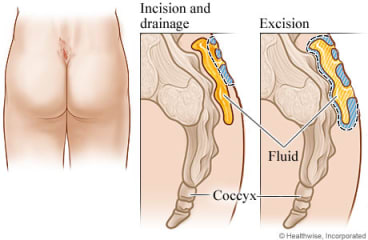Your Child's Recovery

After surgery to remove a pilonidal (say "py-luh-NY-dul") cyst, your child may feel a little tired and sore. How long it will take for your child to heal depends on the way the surgery was done. Any scars will fade over time.
Your child probably had a sedative to help relax. Your child may be unsteady after having sedation. It takes time (sometimes a few hours) for the medicine's effects to wear off. Common side effects include nausea, vomiting, and feeling sleepy or cranky.
Most children can go back to school or day care within a few days to a couple of weeks. Your child's doctor will let you know what to expect. Until the area has completely healed, your child will need to avoid strenuous exercise and sitting for long periods of time.
This care sheet gives you a general idea about how long it will take for your child to recover. But each child recovers at a different pace. Follow the steps below to help your child get better as quickly as possible.
How can you care for your child at home?
Activity
- Allow your child's body to heal. Don't let your child move quickly or lift anything heavy until your child is feeling better.
- Have your child rest when feeling tired.
- Have your child avoid sitting for a long time while healing. And keep your child from sitting on hard surfaces.
- Many children are able to return to normal activities within a few days to a couple of weeks, depending on the type of surgery they had.
- Your child can take a shower. Be sure they pat the area around the incision dry. Don't have your child take a bath until the incision is completely healed.
Diet
- Your child can eat their normal diet.
- If your child's bowel movements are not regular right after surgery, you can help your child to avoid constipation and straining. Have your child drink plenty of water. The doctor may suggest fiber, a stool softener, or a mild laxative.
Medicines
- Your doctor will tell you if and when your child can restart any medicines. You will also get instructions about your child taking any new medicines.
- Be safe with medicines. Read and follow all instructions on the label.
- If your child is not taking a prescription pain medicine, ask your doctor if your child can take an over-the-counter medicine.
- If the doctor gave your child a prescription medicine for pain, give it as prescribed.
- Store your child’s prescription pain medicines where no one else can get to them. When you are done using them, dispose of them quickly and safely. Your local pharmacy or hospital may have a drop-off site.
- If the doctor prescribed antibiotics for your child, give them as directed. Do not stop using them just because your child feels better. Your child needs to take the full course of antibiotics.
Incision care
- If your child's incision was closed with stitches:
- Wash the area daily with warm, soapy water and pat it dry. Don't use hydrogen peroxide or alcohol, which can slow healing.
- You may cover the area with a gauze bandage if it oozes fluid or rubs against clothing. Change the bandage every day.
- Keep the area clean and dry.
- If your child had stitches, the doctor will tell you when to come back to have them removed.
- If your child's incision was left open to heal, change the bandage as instructed by your doctor.
- Bandage changes may hurt at first. Giving pain medicine to your child about half an hour before you change the bandage can help.
- If your child's bandage sticks to the wound, try soaking the bandage in warm water for about 10 minutes. Then remove it. You can do this in the shower. Or you can do it by placing a wet washcloth over it.
- You may notice greenish gray fluid from your child's wound as it starts to heal. This is normal. It is a sign that your child's wound is healing.
Other instructions
- Try using a coccyx cushion if sitting is uncomfortable for your child. This type of cushion keeps pressure off the tailbone (coccyx).
- In some cases, keeping the area free of hair can prevent problems. Ask your doctor if hair removal is needed and what method of hair removal they suggest.
Follow-up care is a key part of your child's treatment and safety. Be sure to make and go to all appointments, and call your doctor if your child is having problems. It's also a good idea to know your child's test results and keep a list of the medicines your child takes.
When should you call for help?
Call 911 anytime you think your child may need emergency care. For example, call if:
- Your child passes out (loses consciousness).
- Your child is short of breath.
Contact your doctor now or seek immediate medical care if:
- Your child has nausea or vomiting and cannot keep down fluids.
- Your child's incision was closed with stitches and the stitches come loose, or the incision comes open.
- Bright red blood has soaked through the bandage over your child's incision.
- Your child has signs of infection, such as:
- Increased pain, swelling, warmth, or redness.
- Red streaks leading from the incision.
- Pus draining from the incision.
- A fever.
- Your child has pain that does not get better after taking pain medicine.
Watch closely for changes in your child's health and be sure to contact your doctor if your child has any problems.
Current as of: October 1, 2025
Author: Ignite Healthwise, LLC Staff
Clinical Review Board
All Ignite Healthwise, LLC education is reviewed by a team that includes physicians, nurses, advanced practitioners, registered dieticians, and other healthcare professionals.

